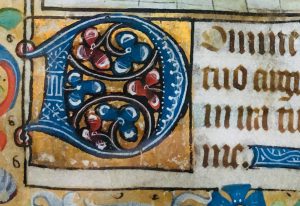The Penitent King David from a Book of Hours
November 27, 2019 in Manuscript Studies

Detached Manuscript Leaf on Vellum
with Framed Illustration and Text
King David with Crown and Lyre
at the Opening of Psalm 6 or 37 (38) in Latin from a Book of Hours
At least circa 125 × 160 mm (as framed and matted)
Rouen, circa 1480–90
or Western France circa 1470
J. S. Wagner Collection
[Posted on 27 November 2019, with updates, for which we thank our Honorary Trustee, James H. Marrow, and our Honorary Invited Associate, Gregory T. Clark.]

J. S. Wagner Collection, Detached Leaf. Opening of Psalm 6 or 37 (38) in 4 lines.
Continuing our exploration of manuscript fragments in our Blog on Manuscript Studies, we welcome a new addition to the quest. See the Contents List for this blog, mostly written by Mildred Budny, for the series of revelations.
From the collection of J. S. Wagner, we offer images from a detached leaf on Vellum in Latin apparently from a Book of Hours. Some of our earlier posts have addressed Books of Hours. See our Contents List.
At present, the Wagner leaf is contained within a frame, so that only one side is visible. It might be the recto or verso of the leaf. If the former, the reader and beholder would have to turn the page in order to advance to the sequential text. If the latter, the facing page would have manifested it at a glance.
As it stands, the page presents the illustrated opening of one of the Penitential Psalms in Latin in the Vulgate Version from a luxurious Book of Hours. The ambition of its production is manifested by the script, illustration, and decoration, as well as the use of gold and other pigments. The quality of the execution, however, exhibits some haste in places.
The set of Penitential Psalms comprise Psalms 6, 31, 37, 50, 101, 129, and 142 (that is, 6, 32, 38, 51, 102, 130, and 143 in the Hebrew numbering).
The opening of text upon the page corresponds to Verse 1 of both Psalm 6 and Psalm 37 (38). See below for those options. That is, at present, given the state of the leaf, we don’t know which.
Now contained within a frame behind glass, this page might represent the recto or the verso of the leaf. For example, if the other side (if the verso) continues the text, it would establish which Psalm is represented. If the other side (if the recto) is the formerly previous text, then it might designate some Psalm or otherwise in the liturgical sequence.
Needless to say, problems aplenty can arise when a leaf is excised and dispersed without accompanying information. (Examples and their challenges appear in many of our blogposts. See our Contents List.)
Call it detective work, and you would be right on track. The good thing is that sharing of images and information might yield increased knowledge. We thank the owner for sharing his images with us, and we thank our friends, colleagues, Associates, and Trustees for helping to discover more information about the center from which this leaf came.
